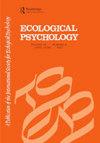The Senses Considered as One Perceptual System
IF 1.7
3区 心理学
Q3 PSYCHOLOGY, EXPERIMENTAL
引用次数: 45
Abstract
ABSTRACT J. J. Gibson (1966) rejected many classical assumptions about perception but retained 1 that dates back to classical antiquity: the assumption of separate senses. We suggest that Gibson's retention of this assumption compromised his novel concept of perceptual systems. We argue that lawful, 1:1 specification of the animal–environment interaction, which is necessary for perception to be direct, cannot exist in individual forms of ambient energy, such as light, or sound. We argue that specification exists exclusively in emergent, higher order patterns that extend across different forms of ambient energy. These emergent, higher order patterns constitute the global array. If specification exists exclusively in the global array, then direct perception cannot be based upon detection of patterns that are confined to individual forms of ambient energy and, therefore, Gibson's argument for the existence of several distinct perceptual systems cannot be correct. We argue that the senses function as a single, irreducible perceptual system that is sensitive exclusively to patterns in the global array. That is, rather than distinct perceptual systems there exists only 1 perceptual system.感官被认为是一个知觉系统
j·j·吉布森(1966)拒绝了许多关于知觉的经典假设,但保留了一个可以追溯到古典时代的假设:分离感觉的假设。我们认为,吉布森对这一假设的保留损害了他对感知系统的新概念。我们认为,动物与环境相互作用的1:1规范,是直接感知所必需的,不能存在于光或声音等环境能量的个体形式中。我们认为规范只存在于突现的、高阶的模式中,这些模式跨越了不同形式的环境能量。这些涌现的高阶模式构成了全局数组。如果规范只存在于全局数组中,那么直接感知就不能基于对局限于个体形式的环境能量的模式的检测,因此,吉布森关于存在几个不同感知系统的论点就不正确了。我们认为,感官功能作为一个单一的,不可约的感知系统,是敏感的模式在全局数组。也就是说,不存在不同的感知系统只存在一个感知系统。
本文章由计算机程序翻译,如有差异,请以英文原文为准。
求助全文
约1分钟内获得全文
求助全文
来源期刊

Ecological Psychology
PSYCHOLOGY, EXPERIMENTAL-
CiteScore
3.30
自引率
10.50%
发文量
8
期刊介绍:
This unique journal publishes original articles that contribute to the understanding of psychological and behavioral processes as they occur within the ecological constraints of animal-environment systems. It focuses on problems of perception, action, cognition, communication, learning, development, and evolution in all species, to the extent that those problems derive from a consideration of whole animal-environment systems, rather than animals or their environments in isolation from each other. Significant contributions may come from such diverse fields as human experimental psychology, developmental/social psychology, animal behavior, human factors, fine arts, communication, computer science, philosophy, physical education and therapy, speech and hearing, and vision research.
 求助内容:
求助内容: 应助结果提醒方式:
应助结果提醒方式:


